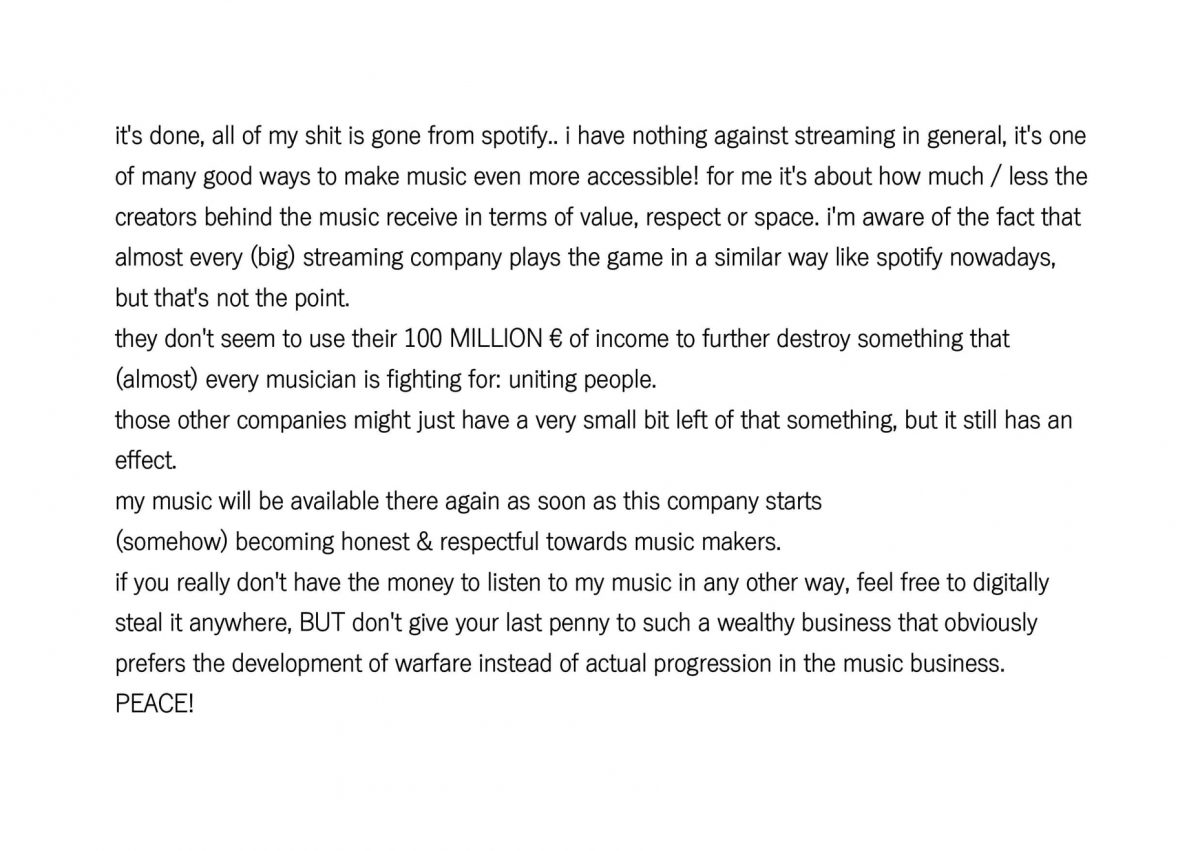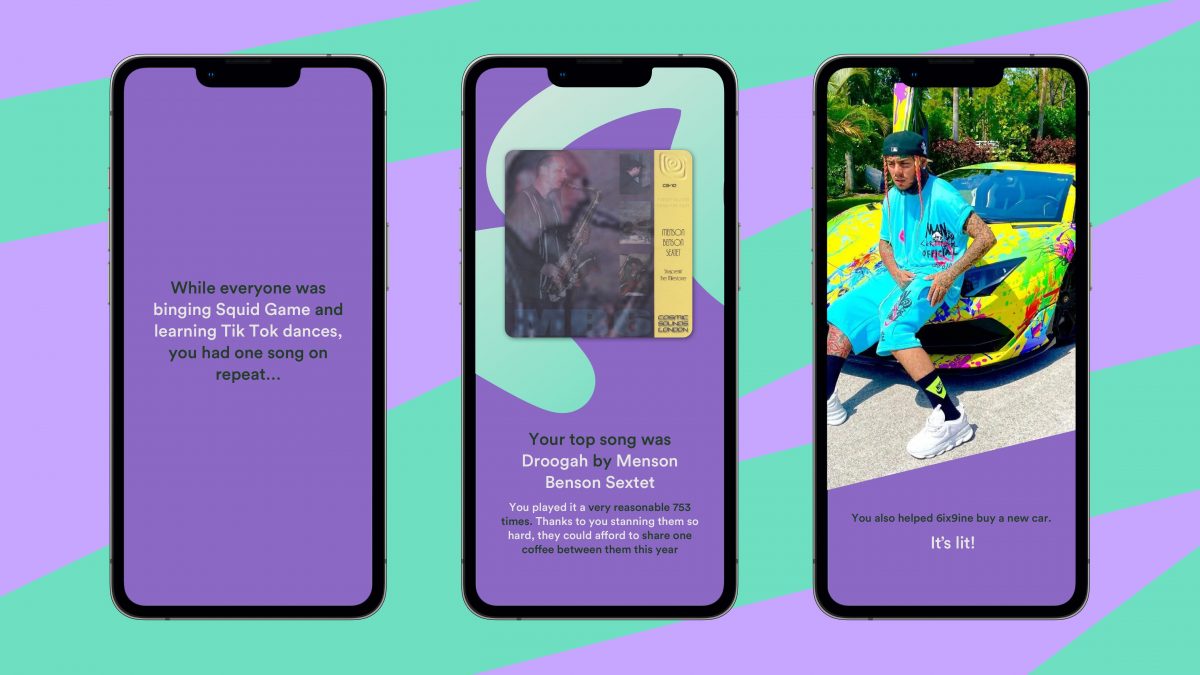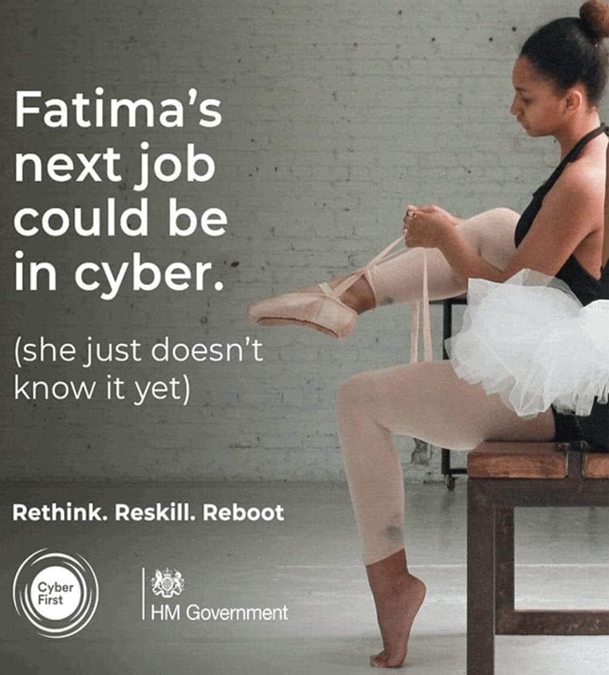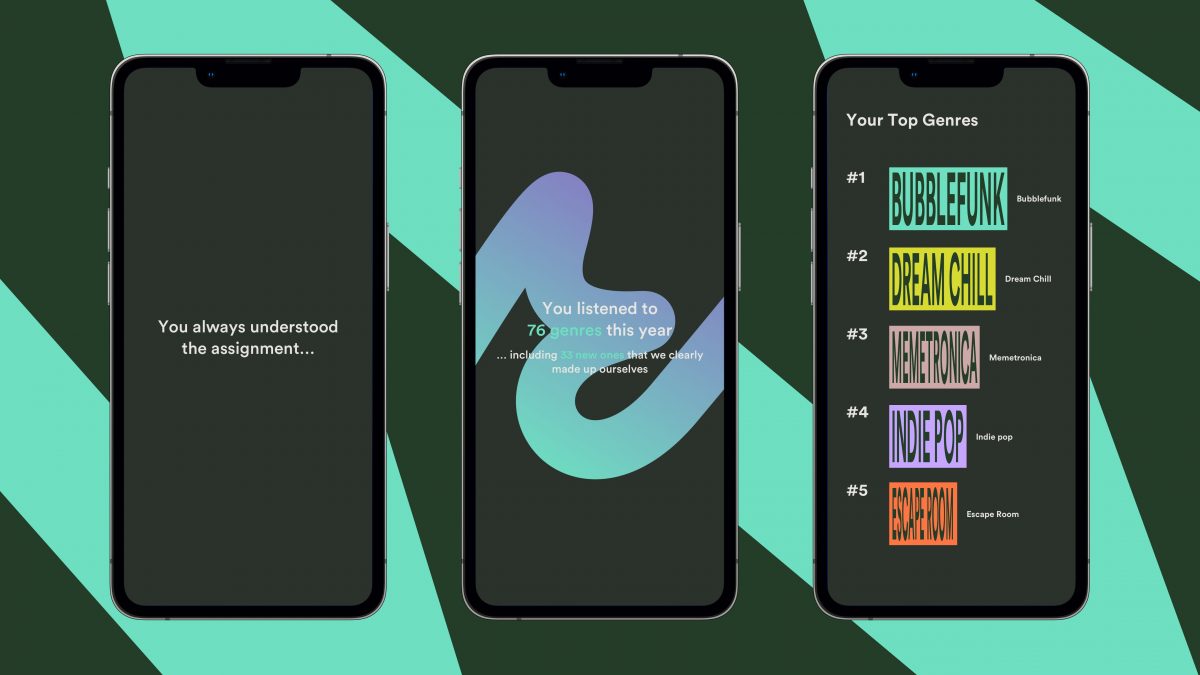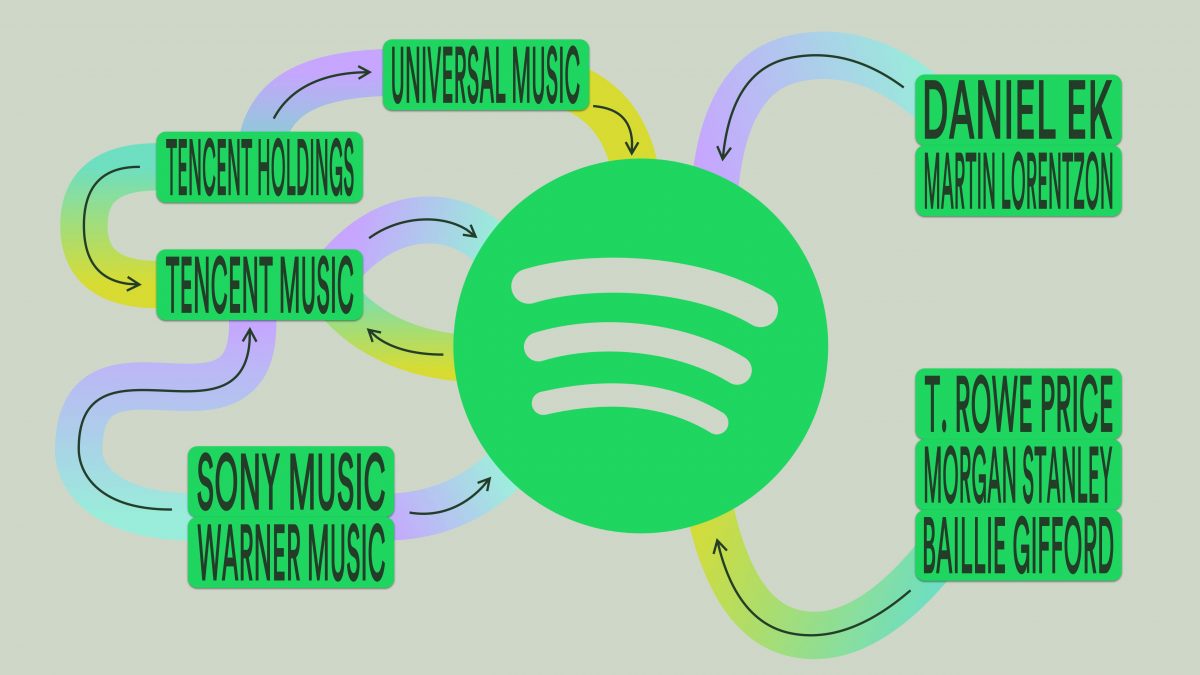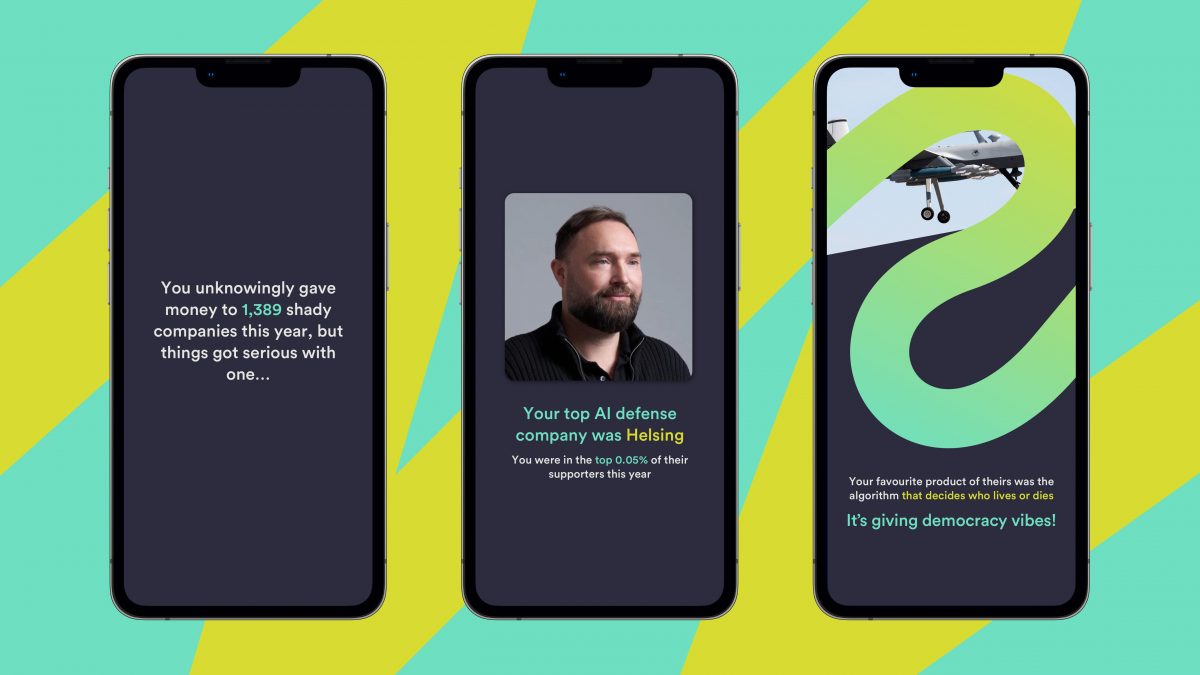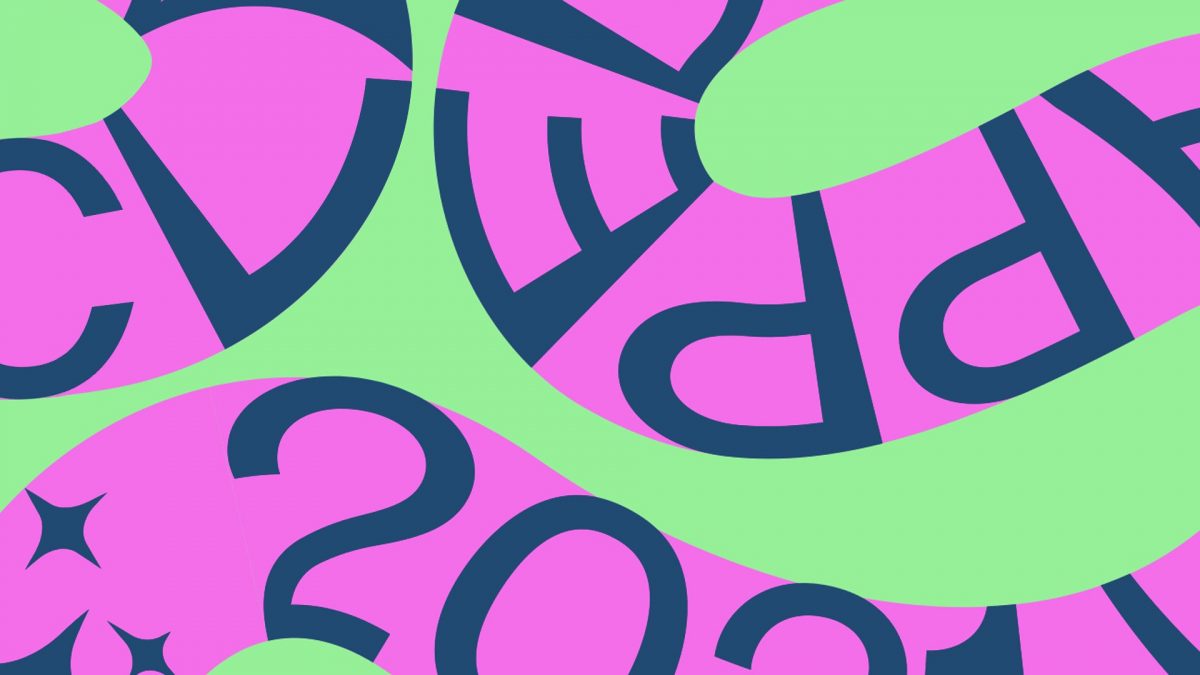Parent to
✣life is beautiful, coordinator and lifegiver to a constellation of live shows and streams of music, aloisius made us an origami crane of sounds folded, refolded and unfolded into new forms. Life is beautiful.

In 1988, On the Silver Globe premiered at the Cannes Film Festival. In 1977, the film was left unfinished after the Polish government’s vice-minister of cultural affairs ordered its production to be shut down believing it was anti-government propaganda. The film’s director Andrzej Żuławski had previously left his native Poland in fear of this kind of censorship. A Vice article on the film states “Zulawski’s film is neither pro-Communist nor pro-Catholic. Instead, it is an ideological goulash, drawing equally from Buddhism, apocryphal Christianity, historical materialism, Nietzsche and Schopenhauer to produce a powerful meditation on the human drive to produce meaning in a universe devoid of any.” 
On the 3rd November 2023, two industry monoliths merged in a cataclysimic supernova of smirnoff ice and unmastered .mp3s. Legendary music and cosmic revelations ensued.

January 17th, 2025.

We’re putting on a gig this November at south London HQ Avalon Cafe. It’s a collab with the penpals and brainboxes at
breakwith.me – friends, family, freaks, all sharing sounds. There will be live performances from mohammad adam, Sirius, Bad Sip, and Pazeamor, with DJ support from Gribs and Able Archer. Intimate and joyous, you really want to be there! It’s gonna be extremely excellent.

We launched Issue #2 in November 2022 at Avalon Cafe, joined by some really close friends of the magazine for an extended 7 hours of the best sounds in the universe. It was warm, it was fun, it was vibe-full to the maximum. The music, as you can hear from the recordings below, was excellent, emobdying the breadth and life we hold so central to Texture as a project :~)

A book in the Norberg town library is shown to me by the librarian. It’s written by her husband Lars-Erik Lärnemark and its title translates as:
In the Morning We’re Running Back to the Mine. Within its pages are scores of songs from the region. Worker’s songs from the 19
th century and older. Songs of celebration, quotidian life, resistance. Worker’s songs which tell a history, the material conditions of their labour read in these passed-down melodies. But to whose ears now? Their places of work rest emptied or reclaimed by the forest. Lost industry in the UK and US inspired famed 90s raves: Manchester’s
The Haçienda;
The Awakening;
Eclipse;
Sunrise – these are spaces which echoed the strikes, chants against cruel optimisation which repeat now only in notation, their sounding replaced by euphoric, troubled music. In Sweden,
Norbergfestival presents a different relationship with the post-industrial.

Last summer’s mission involved grifting my way into as many free festival tickets as possible. Back in June I’d managed to secure press access to Primavera Porto to shoot footage for a non-existent documentary about the impact of recent economic fallout on UK DJs touring the continent – an issue central to this ecology that I’m certain essential contemporary journals like the DICE and Pirate Studios blogs will be allocating adequate resources to, considering their colossal stakes.

In the club before 11 ‘o’ clock. Texture Tape 038 is delivered by palindromic duo WAAW, and lives up to their blistering club sets. Listen on the move.

Fantasy breathes through Salamanda’s nimble production like delicately blown glass, expanding the limits of the listener’s imagination with wordless storytelling. “At times our music becomes an escape, for us and maybe our listeners too” Sala (who also goes by Uman Therma) reflects via email; “I hope our music can somehow act as a shelter”.

You will be aware that Kanye West is a controversial figure. His solo career began in 2002 with a crash: after falling asleep at the wheel on his return from the studio at 4am, he drove head-on into another vehicle, breaking the driver’s legs. Two weeks later he chronicled this experience and his subsequent reconstructive surgery in his first single, ‘Through the Wire’ which, in typical Kanye style, gloriously bent and distorted a soulful Chaka Khan sample:

There are few feelings as unique but universally shared among digital natives as the absolute frustration and dread accompanying the realization that one has forgotten their headphones and must face the day without them. No morning news podcast, no tuning out beggars, buskers, solicitors, classmates and coworkers, no evening workout playlist; just you and the world, painfully unfiltered.

Rave was a phenomenon with togetherness at its core. Physical togetherness in how spaces were filled and bodies interacted; musical togetherness in the shared musical experiences and collaborative act of DJing; and social togetherness, post-Thatcher when society’s fractures ran deep.

The sudden news of Jordan Alexander Groggs’ death in the summer of 2020 saddened me immeasurably. Since 2013, Stepa J. Groggs had formed part of alternative hip-hop outfit Injury Reserve with fellow rapper/vocalist Nathaniel Ritchie (Ritchie with a T) and producer Parker Corey, three minds whose boundless creativity had cemented the group’s reputation as one of the most distinctive and progressive in underground rap. Their output is one crammed with party bangers and slow jams, bursting with abrasive industrial aggro and jovial old-skool charisma, peppered with acerbic diatribes and introspective reflection, all the while interrogating the boundaries of what can feasibly be labelled ‘hip-hop’. What’s more, this was achieved over the course of a handful of mixtapes and one studio album – they were just getting started.

For someone who has always considered themselves
into music, I have recently come to the realisation that actually I don’t know anything at all.

Over the course of our conversation it becomes apparent just how much the act of sharing, of mutual construction and creation, means to Racine. In the latest Texture Tape, the Quebecois producer opens us up to a selection of music new to his ears – considerately chosen with a keen desire to elicit both warmth and disquiet.

“Our mission is to unlock the potential of human creativity—by giving a million creative artists the opportunity to
live off their art and billions of fans the opportunity to enjoy and be inspired by their creators.” These are the lofty ideals alleged to have driven Spotify to their spot
at the top of the music streaming pile. The current reality however, is one of intense struggle, burn out and unlivable wages for pretty much everyone except Joe Rogan, Drake and the company’s senior management. But this failure to live up to their own principles is not because the river has run dry, far from it. In 2020, music streaming revenue grew to
$13.4 billion worldwide from 11.4 billion the previous year and is predicted to reach
$37 billion by 2030 with Spotify being one of the main benefactors of that growth. The reason for artists feeling disrespected and undervalued within their own industry comes as a direct result of this growth. As labels and streaming platforms have vied for position in this exploding market, it has become a race to the bottom to see who can hyper-exploit artists the most. It is little wonder then, that artists like Skee Mask are beginning to jump ship in protest of Spotify’s inability to provide “value, respect, or space”.

DeForrest Brown Jr.’s 2020 release as
Speaker Music, ‘Black Nationalist Sonic Weaponry’, thrust me into an interior space I don’t think I have occupied before or since. The music is mesmerically uncertain. Strung-out with pain, tension, and a deep-seated need to express the brutal reality of the intersecting racist and capitalist endgames that dominate our contemporary existence. Witnessing a live performance at Camden Arts Centre in early October brought me back into this space. It was vitally and necessarily inspiring. Where
platform capitalism has increasingly flattened and homogenized music consumption, this was a luminescent experience in the face of our decomposing horizons.

Assembled by Georgie McVicar, Texture Tape 036 is a kaleidoscopic journey as refractive as their new album – the quietly stunning
Tiny Grassland. The mix weaves a sea of samples and instrumentation into a blanket of many threads, a patchwork quilt of influences and musings. It’s a fitting accompaniment to the album and it’s adjacent book, both
out now via Mutualism – get comfy and dig in.

Texture Tape 035 has been brought to life by
ANE label head
Mistareez. A distinguished producer in his own right, the mix covers the spectrum of contemporary ambient sounds, from dusty to dubby, spliced vocals to supple warmth. Drawing on a trove of mystery trax and personal influences, this one comes straight from the source. It’s the sound of a cozy day in or a hazy morning after. You decide.

Our next instalment of the Texture Tapes series comes courtesy of South London-based duo FYI Chris, whose eagerly anticipated debut album
Earth Scum arrives on 5th March via Black Acre Records. They’ve already shared a handful of head-turning teasers from the album, including ‘Scum of the Earth’, a belter of a track which layers Thick Richard’s gnarly poetry over bruising broken beats.

Buckle up, because our first Texture Tape of 2021 is an absolute belter from start to finish. We couldn’t be happier to welcome L.A.’s Kaili to the mix series, nor could we feel more juiced up after listening to her turn up the pressure with pumping club workouts and raucous bootlegs. This mix is an exercise in how to chop tunes that are bursting with energy while keeping things tight and controlled. At a time where many of us are feeling spent after just 10 days of 2021, here’s some much-needed fuel to top up your tank.

Using burning synths and dusty guitar licks, Ben Khan taps into an aesthetic that is at once both futuristic and soulful. His latest instalment to his
Crimson EP series,
Crimson GEN2, is inspired by the time he has spent living in LA, documenting his experience of the “lonely sprawl of the megacity”.
GEN2 oozes like candle wax, as Ben’s reverb-soaked vocals melt into a swirling fusion of indie electronica, alt R&B, funk and Pakistani hip-hop.

It’s Friday night, and you’re heading round to a gaff with your pals from art school. It’s not your usual skeezy piss-up, it’s one of those parties where all the boys have tiny beanies and all the girls have new wave mullets. It is, for all intents and purposes, a Cool Party. It’s good fun, until you notice that the aux is working its way towards you. Christ. What will you put on? The fate of your interactions for the rest of your night rests upon this.

This week we have Gracie T blessing us with a mix that’ll have you pining for the club. The rapid shifts between jersey club thumping and hyperpop twinkling provide a well needed jolt of energy to keep our spirits up during a difficult time. Perfect for an at home boogie!

A video frame centres on a pair of hands, steadily working their way through a dozen or so parcels. One by one, the goodies inside are revealed: a pastel anime girl on a white long-sleeve top, swim shorts branded with the SEGA logo, a candle shaped like a disfigured Roman bust. Out of shot, a voice cuts in, explaining that all these items are available at Vapor95, the “go-to” online store for clothing and accessories themed around ‘vaporwave’, a retro internet microgenre built from looped fragments of 80s/90s pop and lounge music.

To preface this article on music streaming and mental health, I want to first acknowledge that in the period between first completing the research for this piece and its publication Spotify have released a new feature for their platform known as Daily Wellness. These weekly playlists contain a “mix of music and wellness to guide you through your day” and while this is certainly a neat idea that I commend them for implementing, it differs from what I will go on to discuss in its formatting and execution. Critically, it is not a purely music-based tool, including some bite-sized mindfulness podcasts that, to my mind, interrupt the flow of some well personalised feel-good music. While some may well find this useful, listening to the same hackneyed tropes about self-care that I’ve heard repeated ad nauseum makes my eyes roll so hard that my retinas almost detach (see: “activating your purpose”, “creating stress breakthroughs”, “finding your resonant archetype”, etc.). 
Ow! It’s really bright out here.

Our (really!) last mix before a hibernation slumber comes courtesy of Rachael. Part of the brilliant team behind Rye Wax and creator of the killer Ambient Babestation Meltdown, she wastes no time in making her intentions clear with a mix that speaks to the current state of society and all of the frustration that brings with it. Quite frankly the mix is a bruiser, driving headfirst into a dark fog and emerging with grimly defiant energy. Electro, EBM, and classic techno meld into the fringes of new wave and beat. It’s a journey to the other side of complacency, with the accompanying realisation that the worst is yet to come.

Scud blesses the 28th instalment of our mix series with a mesmerising mix of sounds guaranteed to stimulate your quarantined ears. The Dad Tracks co-founder skitters between scuzzy industrial and jagged broken beats and footwork, before wrapping things up with some ambient to ease the soul.

Returning after a few weeks off, we’re absolutely delighted to share with you a breathtaking new tape from Airali & L.P.B of Co-Select, a London-based collective advocating gender equality in DJ culture. This killer mix sees the pair dishing out glitchy, odd-socked IDM and drum & bass belters, like being dazzled by brilliantly bright billboards as you hurtle through a busy city at night.

An absurdist exercise in musical volatility, an album trilogy largely consisting of Smash Mouth mashups, and ‘Old Town Road’. What do these things have in common? On paper they really shouldn’t work. And yet, somehow, they do. That wasn’t a punchline, but rather an observation indicative of a wider trend that has caught my attention. It’s related to the rising potential of the gimmick not only to disrupt the mainstream, but also to be utilised in the pursuit of something beyond mere schtick. Earlier this year, outsider pop duo 100 gecs released their outrageously eccentric debut album
1000 gecs, kicking up a real fuss amongst the usual suspects of online discourse, Pitchfork and The Needle Drop in particular.

Located on the site of a former S-bahn railway station bordering Kreuzberg – an area in Berlin that has experienced rapid gentrification over the past decade – Görlitzer Park (or ‘Görli’ to locals) is currently under threat by state attempts to ‘clean up’ the city’s shadier areas. Police crackdowns on rave gatherings and drug-dealing in the park are endangering the liberal values and counterculture that have made Kreuzberg one of the most tolerant and multi-cultural areas in Berlin.

The first tape of the year is served up by Sydney-based producer aurA, whose sub-aquatic broken beat cuts wobble and fizz under the weight of the water above them.

‘We love to surprise ourselves, in a myriad of ways’, says Gribs, DJ and co-runner of London-based label TT (fka Tobago Tracks). ‘We’re getting a better sense of what function we want the label to serve…and what it can be both in the music industry and in the wider world.’

Flora Yin-Wong circles between both embracing her heritage and rejecting it. It’s got to the point where, as she puts it, “I’m appropriating my own culture”, sampling the East Asian religious and cultural scene she was never part of. We caught up with the Chinese-Malaysian London-based producer, writer and DJ, straight after her afternoon panel talk at Wysing Polyphonic X Somerset House Studios, a late Summer festival situated just outside Cambridge. Knelt down on the chilly grass outside the café venue, we asked her about superstition, and her sonic montages which have captured the attention of international artists, and notable music platforms alike. As we found out, the Wysing organisers never had ambitions of Glasto-level stage production or crowds – they reached out to a handful of select artists, keen to help them hone their craft and continue a dialogue. The question put to them was simple: “why don’t you come along?” Giving the space for producers or DJs to manifest their visions turned out to be something really special. Before we delve deeper into our conversation with Flora, we’re going to give an overview of the day itself.

Tom Graham chats to the Tobago Tracks affiliate about mumble rap, defining his style as ‘pop music’, and how he uses lyrical obscurity to heighten his music’s emotional resonance.

Morwell eases us in with a couple of real chin-strokers before turning it up to 11 with some delicious breaks. This mix is an excellent showcase of Morwell’s left-field sensibilities and serious production chops – here, we have a number of prime cuts from his recent musical endeavours, including both remixes and originals.

Setting the tone with some sweet slow jams, the Newcastle-based DJ dives deep as he drifts between floaty cruisers and chunky house groovers. Get on it.

I’ll admit that I was especially excited for Dimensions and Outlook in 2019. The sister festivals, held for the last decade in an ancient fort 20 minutes outside of Pula, Croatia, pair an iconic seaside venue with a well-financed and tasteful selection of artist bookings. The lenient (or altogether absent) Croatian licensing laws allow competing sound-systems to push for their dream set-ups, often to downright scary results, and the encompassing surroundings, a Summer campsite peninsula on the Adriatic, make your next-day comedowns quite literally a breeze.

References to the glory years of 90s rave dominate today’s musical landscape, from the abundance of hardcore’s breakbeats and rave stabs in present day music production, right down to the design of event posters. Yet for something so culturally significant that it still shapes music and fashion 30 years on, the ‘second summer of love’ is something of a myth for most of today’s dance music fans; a hedonic ideal we can only learn about indirectly through the tales and images provided by those who really were there.

Leeds-based selector Babyschön dazzles us with a delightfully-crafted mix designed to keep you on your toes, loosely drifting between new wave, post-punk and shoegaze. Big tip!

The inaugural edition of
We Out Here arrived at a fortuitous moment for us. Following the immense disappointment of the cancelled Houghton, it promised a comparatively calm, expansive experience in a similarly picturesque niche of quaint rural England. It should not however sit in the shadow of Craig Richards’ leviathan – the line-up was suitably, refreshingly diverse and aimed squarely at the immense curatorial talent of Gilles Peterson. Performances from vast swathes of the Brownswood and Worldwide FM rosters were promised, alongside a motley crew of selectors and musicians offering everything from chilled out jazz to mind-bending tehcno.

For the 21st instalment of our Texture Tapes mix series, we’re delighted to be handing the reins over to Minna Eyre! With ease, she glides through a selection of deliciously deep and quirky house cuts, subtly shifting between vast, expansive atmospheres and slick, smooth swagger.

ockquote class="wp-block-quote">
“Everyone wanted to be part of it. They didn’t necessarily see it as a commercial exercise — more a creative one.” 
My first attempt at composing a set of questions for Tom Scholefield, aka
Konx-om-Pax, resulted in a muddled two and a half pages of ideas. He’s a figure with a long history of collaboration and creation on the cutting edge of both music visuals and production, and my initial approach was all-encompassing: Broad in scope but relatively aimless in it’s attempt to draw together the many threads of his continued practice. As a graduate of the Glasgow School of Art, he’s a graphic designer and animator by training and yet currently occupies a small but growing niche of creators as talented sonically as they are visually. These languages frequently overlap, and so when artists arrive who can straddle this divide the resultant work is far more impactful than the sum of its constituent parts.

This week’s tape sees Berlin via Guildford selector NYDS glide through atmospheric breakbeats, before settling into the groove with some bouncin’ house and techno pumpers.

I’m sitting in the midday sun whilst the soporific chimes of
Wanderwelle mingle with the sounds of wood-pigeons and long grass whispering in the breeze. A brief interlude of shimmering chords draws me out of my daze, and I’m once more reminded that there’s more to ambient music than initially meets the ear. From the drippy, luscious synths of Harold Budd to the languorous soundscapes of Stars of the Lid; from the tranquil jazz-tinged folk of Penguin Café Orchestra to the soft cosmic chug of Tangerine Dream, ambient refuses to be characterised by a singular acoustic pallet and derives inspiration from any number of musical styles. The genre is characterised by its emphasis on atmosphere over structure, on tone over rhythm, but this rather broad definition offers immense space for interpretation. To attempt to draw the lines between what is ambient and what isn’t would be a long and pointless exercise, but listening and searching for value within it is a worthy and calming pursuit.

Hotly tipped producer Avernian graces us with a deeply layered mix, full of percussion, dark ambience, and one (or two?) of his own productions.

Amidst a strangely stoic community of online record buyers, where online comments tend to read more like robotic essays rather than normal human opinions, one topic alone stirs emotion: the
Discogs Shark.

Since her chart-topping ‘
7 rings’ dropped in January, waves of outrage against Ariana Grande for appropriating Japanese and Black culture spread across social media. It inflamed accusations against Ariana of plagiarism; after the single was released,
Princess Nokia and
Soulja Boy posted videos accusing the singer of stealing their rap flows, slipping into a fairly gray area about ‘inspired’ verbal rhythms and rhyme patterns. ‘You like/ my hair?/ Gee, thanks/ Just bought it’, chimes Ariana, projecting an image of maturity.

Irokee is at the helm for this week’s tape, which takes us all the way to Bari, Italy. The beginning of the mix exudes ocean-floor murk, before this dark, cavernous ambience transforms into something much more bassy but just as ominous.

Editor’s Note: I first started writing this piece back in 2018, considerably before hyperpop became such a mainstay and PC Music producers like AG Cook became so well known within pop music in general. This huge shift in the perception of PC Music turns this piece into twee little time capsule which is not something I’d expected at all but am delighted to see.

The growing festival circuit in the UK appears to be going from strength to strength, with a wealth of options at all sizes for those seeking the big and the bold in electronic music. From city-based festivals like Wigflex’s takeover of Nottingham, to the plethora of small weekend-long camping events like Field Maneuvres, We Out Here, and of course stalwarts like Glastonbury, it feels like every combination of tastes is catered for.

This week, Coromandel FM takes us on a deeply personal and nostalgic tour of some of his favourites, old and new. Starting with some more thoughtful jazz numbers, the mix slowly and seemlessly builds into a finale of some seriously euphoric disco, underpinned by a continuous organic feel.

We’re back in Yorkshire again as Sheffield-based Leagueplay puts pedal to the metal for this week’s mix: an invigorating dose of drum and bass that’ll have you feeling like you’re racing down an empty freeway.

Sheffield-based Tom Batchelor gifts us with a selection of loose chuggers, tastefully balancing smoothness and swagger.

International man of mystery and
VIP MIX co-founder Document comes at us with a mind-expanding slew of tunes and ‘too much harpsichord’.

Laced with razor-sharp cuts of gqom, UK funky and broken beat, Bristol-based Bandicoot isn’t pulling any punches with this one.

A few weeks ago, after lengthy negotiations with the landlord and building contractors over rent and fire safety renovations, Oxford’s venue The Cellar closed its doors for the last time. The news felt almost anti-climactic: after the last couple of years, which have seen The Cellar fight off the prospect of closure more than once, the basement club seemed invincible. 13,000 people signed a 2017 petition to prevent the club’s redevelopment into a retail space, and a further 2,000 donated over £92,000 in just over 4 weeks to the ‘Cellar Forever’ crowd-funder in 2018. Sadly, this overwhelming support was not enough: on 11th March 2019, the venue ended its over 40-year-long tenure as the beating centre of Oxford’s independent music scene, leaving a sweaty, low-ceilinged hole in the city’s heart.

>
Tom Graham chats to the Simple resident about changing cities, DJ mentoring, and her favourite tracks.
Oxford’s longest running party, Simple, celebrates its 20th birthday this year. Its appeal among students and locals alike stems in part from the vastness of their bookings, having welcomed to The Bullingdon the likes of DJ Stingray, Objekt, Mall Grab, Anastasia Kristensen, Saoirse, Helena Hauff, and many more. Perhaps just as enticing is the strong, dependable reputation the Simple team have spent years crafting, and the reliability of their residents to set the tone with skillful yet steady dynamism. At the centre of this Simple identity is Em Williams, the Bristol via Oxford-based DJ whose sets are always as much of a treat as seeing the headliner. Her most notable characteristics are her patient approach to the dancefloor and dextrous ability to weave weighty yet restrained selections. Able to support the range of artists that Simple book, Em’s malleable style ensures she somehow manages to maintain consistency while still keeping each set fresh. 
Torracinta delivers a selection of off-kilter, watch-your-step weapons.

Jolly Brolly display a deft touch in this lurching dose of dubwise delights. Both heady and headsy.

Back in 1992, ‘rave’ was becoming a dirty word. For many people, it represented all that was non-musical about dance music:
a scene saturated with sample-laden, poorly produced tracks whose sole purpose was to induce drug-fuelled instant gratification for the masses in warehouses, fields, and aircraft hangars. A reactionary movement to hardcore quietly emerged, which aimed to retreat from the hedonistically functional aspects of dance music towards the more ‘creative’ use of technology. Spearheaded by UK labels like Warp and Rephlex Records who hosted artists like Aphex Twin, Autechre and B12, this new subgenre of electronic music is often given the loaded name ‘intelligent dance music’, or IDM. If hardcore was music for the body, IDM was for the mind, and for appreciating either at home or in much smaller, under-the-radar venues.

This week’s mix comes courtesy of SNAFU, mastermind of the
Neon Soup mix series, and he’s laid down the audible equivalent of cruising through the clouds in an iced out limousine

Blessing the controls this week is the enigmatic Neil, comprised of two selectors whose collective voice is playful, bold and raw in equal measure.

Following the inaugural BODY RING, which featured the talents of Laksa, founding father Finn Hardwick aka Wet Hands has produced a finely tuned live recording of his set that evening. Low-tempo and murky in all the right ways, he also sat down to answer a few of our customary questions.

Strong dubstep intonations in this silky mix from Bavs.

Oscar Maury of
VIP MIX wields some truly textural tunes. Sit in a dark room and absorb.

I met Oli Nelson at the Gloucester Green food market – something of an Oxford institution in a different vein to questionable Union speakers and 15th century architecture. Having never actually eaten there he seems enthused by the swirl of life it injects into what is otherwise a pretty average Wednesday afternoon. Much like another Oxford mainstay, Cellar, which inevitably is an initial point of discussion, it’s a place external to the academic trappings of university where people can socialise and enjoy themselves. You can feel life seeping back into the students sitting around as they dig into pad Thai and Tibetan curry in much the same way that you get those rare communal moments of bliss as everyone
smacks the roof before Minor Science drops a huge wheel.

Chalk bleeps his way into our mix series with a deep and dubby journey to Sheffield.

DJ Racso takes us into the deep end with some proper heads down thumpers

Carioca Superficial Club brings us a mix of music to travel to. Make sure to wear your seat belt when making abrupt turns.

DJ Unesco’s offering is explosive in its ingenuity. Listen till the end.

Sleepy T starts us off with a forward-thinking inaugural mix.

Houghton was a festival like no other. Its 24 hour license, abundance of unique acts, and almost complete lack of phone reception made it a utopia for electronic music heads to totally immerse themselves for a few days. With an emphasis on house and techno, this year’s edition featured an eye-watering line-up, hosting a huge number of underground music’s most impressive selectors. In the months leading up to the festival, my friends and I would spot an artist that we previously hadn’t noticed on the bill, and our excitement would continue to build. It seemed like everyone was playing there. Except, they weren’t…

We met TJ Hertz (a.k.a Objekt), the evening before his hotly anticipated set at The Bullingdon. Sitting opposite the man behind the music in the lobby of Oxford Spires Hotel, a long and rainy bike ride out of the city centre, was somewhat surreal, but the Oxford alumnus-turned-international DJ was immediately friendly. “I need a drink,” TJ laughs, “I’ve had three hours sleep”.

Nostalgia has the power to warp memory and identity, accentuating positive associations and blurring away negative ones. It can reduce significant emotions to aberrations at the edge of our retrospective vision, and bring previously unnoticed elements to the forefront. Just witness the way that the crackle of vinyl can pull even the modern listener back to a mythic and often unexperienced musical heyday situated vaguely in ‘the past’. Nostalgia has always been discussed and every generation has looked fondly back upon its precursors, but has increasingly transcended this familiar position in our cultural understanding, and instead become an aesthetic choice.

I’m writing this piece to the driving soundscapes of Rival Consoles, an artist I first came across last year. I’m fairly sure that I discovered him through a Spotify algorithm, most likely a song ‘radio’ manufactured to keep me quietly happy as I focus on something else. All I can really tell you about coming across his music is that I’ve only been listening to it for a few months. The data charting this journey must exist: Spotify could tell me at what second I first listened to one of his songs, how many times I replayed it, what direction I was travelling in, and then provide a disturbingly accurate conclusion about my mindset or listening habits as a result of the intersection of such exact information.

